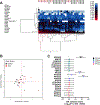Domestic Dogs and Horses as Sentinels of Per- and Polyfluoroalkyl Substance Exposure and Associated Health Biomarkers in Gray's Creek North Carolina
- PMID: 37340551
- PMCID: PMC10802174
- DOI: 10.1021/acs.est.3c01146
Domestic Dogs and Horses as Sentinels of Per- and Polyfluoroalkyl Substance Exposure and Associated Health Biomarkers in Gray's Creek North Carolina
Abstract
Central North Carolina (NC) is highly contaminated with per- and polyfluoroalkyl substances (PFAS), in part due to local fluorochemical production. Little is known about the exposure profiles and long-term health impacts for humans and animals that live in nearby communities. In this study, serum PFAS concentrations were determined using liquid chromatography high-resolution mass spectrometry and diagnostic clinical chemistry endpoints were assessed for 31 dogs and 32 horses that reside in Gray's Creek NC at households with documented PFAS contamination in their drinking water. PFAS were detected in every sample, with 12 of the 20 PFAS detected in ≥50% of samples from each species. The average total PFAS concentrations in horses were lower compared to dogs who had higher concentrations of PFOS (dogs 2.9 ng/mL; horses 1.8 ng/mL), PFHxS (dogs 1.43 ng/mL, horses < LOD), and PFOA (dogs 0.37 ng/mL; horses 0.10 ng/mL). Regression analysis highlighted alkaline phosphatase, glucose, and globulin proteins in dogs and gamma glutamyl transferase in horses as potential biomarkers associated with PFAS exposure. Overall, the results of this study support the utility of companion animal and livestock species as sentinels of PFAS exposure differences inside and outside of the home. As in humans, renal and hepatic health in domestic animals may be sensitive to long-term PFAS exposures.
Keywords: GenX chemicals; One Health; PFOA; PFOS; canine; drinking water; equine; fluoroether; nafion by-product 2.
Conflict of interest statement
The authors declare the following competing financial interest(s): The following authors disclose their associations that could be perceived as potential competing interests with the subject matter discussed in this manuscript: Dr. Kentley Dean is an employee of Southern Oaks Animal Hospital a full-service veterinary medical facility, located in Hope Mills, NC. Mike Watters and Debra Stevens-Stewart are residents of the study area and served as community representatives for this community engage participatory research study. The remaining authors declare no competing interests.
Figures


Similar articles
-
Factors associated with per- and polyfluoroalkyl substances (PFAS) serum concentrations in residents of New Hanover County, North Carolina: The GenX exposure study.Environ Res. 2023 Nov 15;237(Pt 2):117020. doi: 10.1016/j.envres.2023.117020. Epub 2023 Sep 4. Environ Res. 2023. PMID: 37673120 Free PMC article.
-
Measurement of Novel, Drinking Water-Associated PFAS in Blood from Adults and Children in Wilmington, North Carolina.Environ Health Perspect. 2020 Jul;128(7):77005. doi: 10.1289/EHP6837. Epub 2020 Jul 22. Environ Health Perspect. 2020. PMID: 32697103 Free PMC article.
-
PFAS levels in paired drinking water and serum samples collected from an exposed community in Central North Carolina.Sci Total Environ. 2023 Oct 15;895:165091. doi: 10.1016/j.scitotenv.2023.165091. Epub 2023 Jun 23. Sci Total Environ. 2023. PMID: 37355130 Free PMC article.
-
Recent US State and Federal Drinking Water Guidelines for Per- and Polyfluoroalkyl Substances.Environ Toxicol Chem. 2021 Mar;40(3):550-563. doi: 10.1002/etc.4863. Epub 2020 Nov 2. Environ Toxicol Chem. 2021. PMID: 32845526 Review.
-
Per- and Polyfluoroalkyl Substances (PFAS): Significance and Considerations within the Regulatory Framework of the USA.Int J Environ Res Public Health. 2021 Oct 23;18(21):11142. doi: 10.3390/ijerph182111142. Int J Environ Res Public Health. 2021. PMID: 34769660 Free PMC article. Review.
Cited by
-
Novel PFAS in alligator blood discovered with non-targeted ion mobility spectrometry-mass spectrometry.Sci Total Environ. 2025 Jul 10;985:179760. doi: 10.1016/j.scitotenv.2025.179760. Epub 2025 May 29. Sci Total Environ. 2025. PMID: 40446637
-
Quantitative cross-species comparison of serum albumin binding of per- and polyfluoroalkyl substances from five structural classes.Toxicol Sci. 2024 Apr 29;199(1):132-149. doi: 10.1093/toxsci/kfae028. Toxicol Sci. 2024. PMID: 38518100 Free PMC article.
-
Novel PFAS in Alligator Blood Discovered with Non-Targeted Ion Mobility Spectrometry-Mass Spectrometry.bioRxiv [Preprint]. 2025 May 24:2025.03.20.644452. doi: 10.1101/2025.03.20.644452. bioRxiv. 2025. Update in: Sci Total Environ. 2025 Jul 10;985:179760. doi: 10.1016/j.scitotenv.2025.179760. PMID: 40196563 Free PMC article. Updated. Preprint.
-
Variability of Mercury Concentrations Across Species, Brand, and Tissue Type in Processed Commercial Seafood Products.Toxics. 2025 May 23;13(6):426. doi: 10.3390/toxics13060426. Toxics. 2025. PMID: 40559900 Free PMC article.
-
Combined screening and retroactive data mining for emerging perfluoroethers in wildlife and pets in the Cape Fear region of North Carolina.Chemosphere. 2024 Sep;363:142898. doi: 10.1016/j.chemosphere.2024.142898. Epub 2024 Jul 19. Chemosphere. 2024. PMID: 39032729 Free PMC article.
References
-
- Gaines LGT Historical and current usage of per- and polyfluoroalkyl substances (PFAS): A literature review. Am. J. Ind. Med. 2023, 66, 353–378. - PubMed
-
- Bečanová J; Komprdová K; Vrana B; Klánová J Annual dynamics of perfluorinated compounds in sediment: A case study in the Morava River in Zĺin district, Czech Republic. Chemosphere 2016, 151, 225–233. - PubMed
-
- Boiteux V; Dauchy X; Bach C; Colin A; Hemard J; Sagres V; Rosin C; Munoz JF Concentrations and patterns of perfluoroalkyl and polyfluoroalkyl substances in a river and three drinking water treatment plants near and far from a major production source. Sci. Total Environ. 2017, 583, 393–400. - PubMed
-
- Chen H; Sun R; Zhang C; Han J; Wang X; Han G; He X Occurrence, spatial and temporal distributions of perfluoroalkyl substances in wastewater, seawater and sediment from Bohai Sea, China. Environ. Pollut. 2016, 219, 389–398. - PubMed
Publication types
MeSH terms
Substances
Grants and funding
LinkOut - more resources
Full Text Sources
Medical
Research Materials

